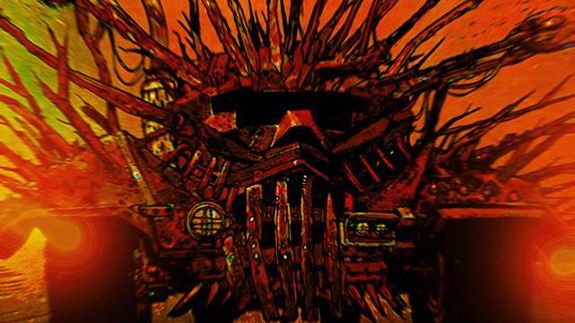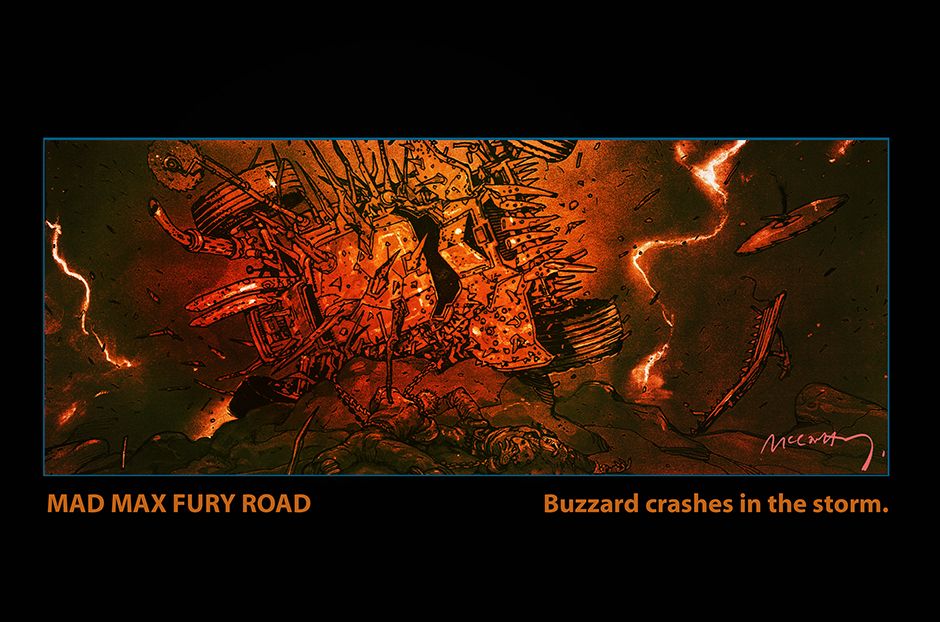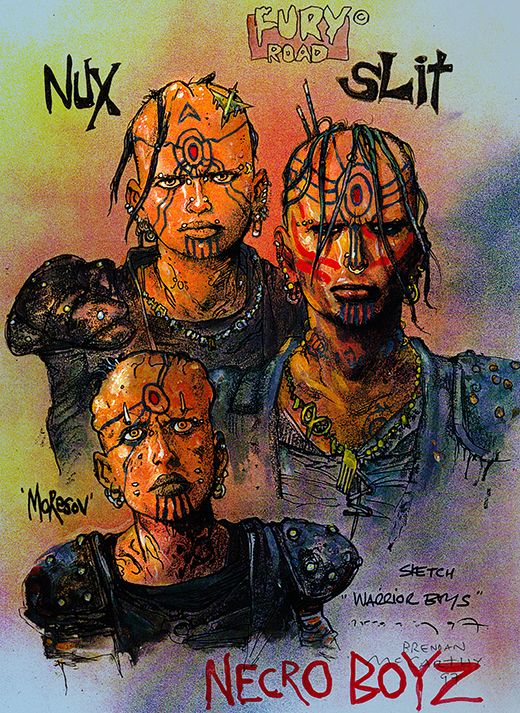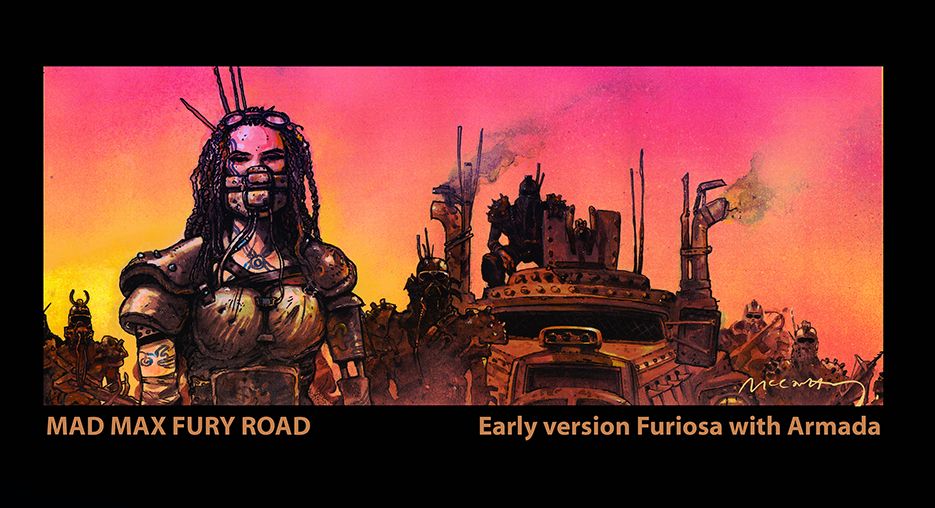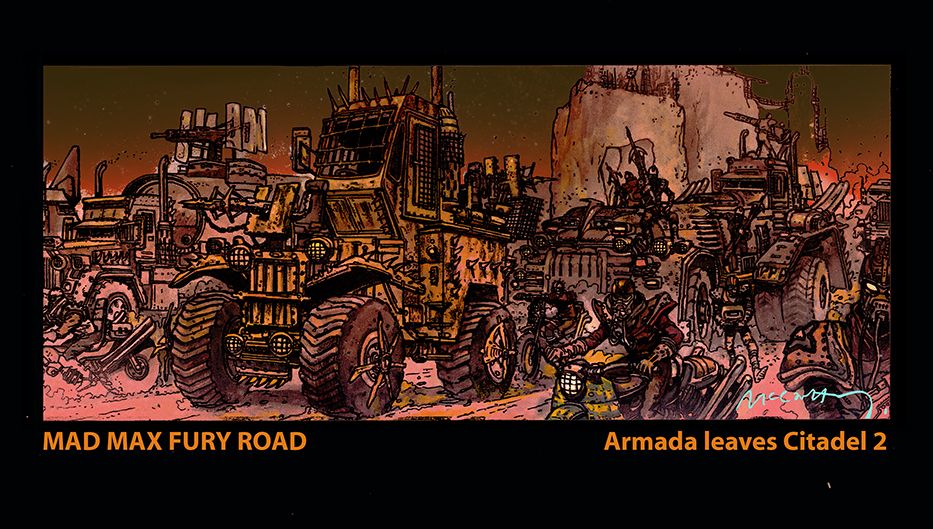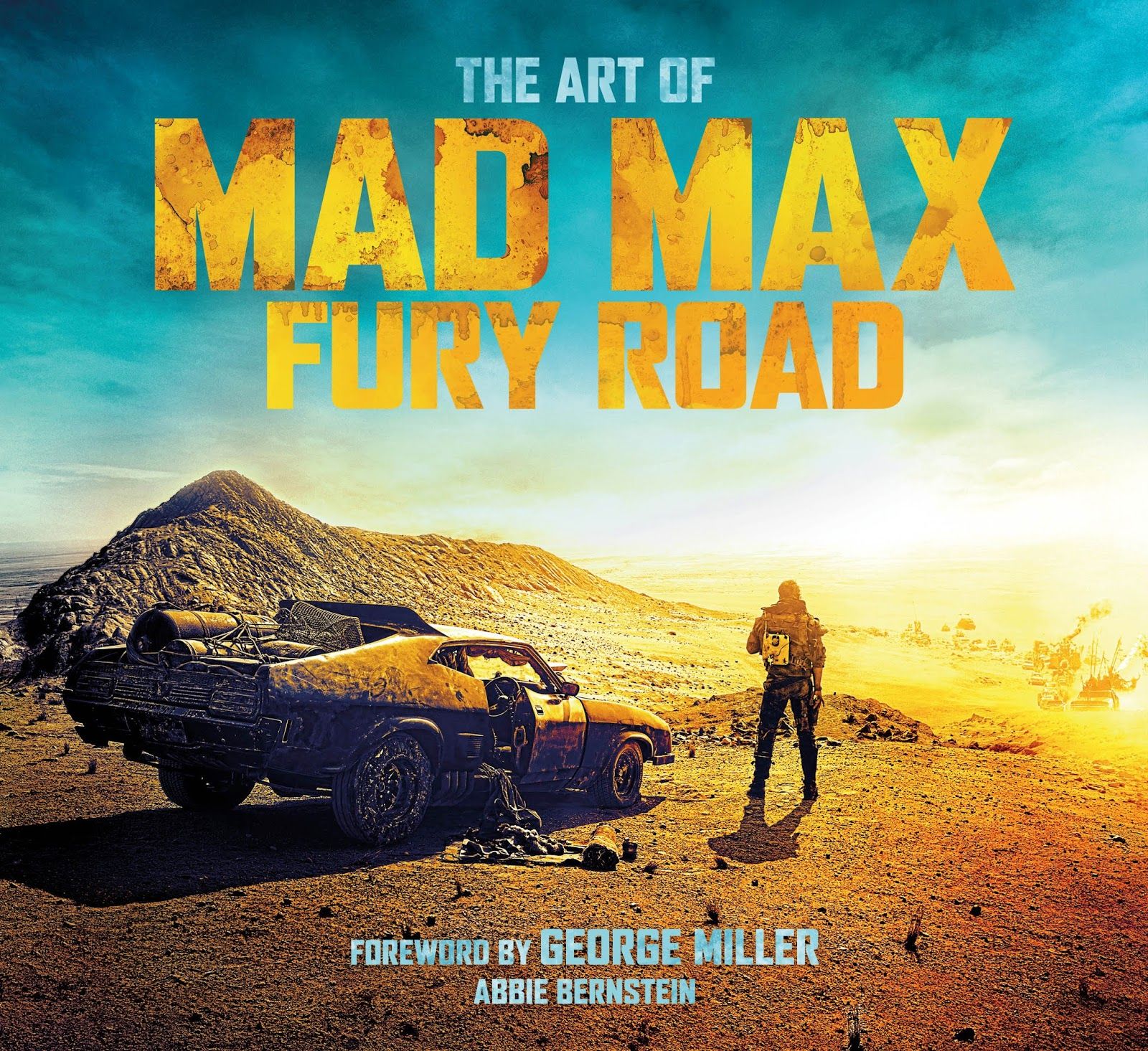"Mad Max: Fury Road" depicts a hellish future comprised of half-life suicide cults, deformed warlords and more welded-together vehicles then every Burning Man festival combined. Directed by George Miller, the mastermind behind the 1979 original, "Fury Road" continues the adventures of post-apocalyptic hero Max Rockatansky, with Tom Hardy taking over the leather jacket from Mel Gibson.
Thanks in large part to the brilliantly twisted designs by concept artist and co-writer Brendan McCarthy," the film is being hailed as the most high-octane action releases in decades. McCarthy's drawings, many of which date back to the late '90s, are now available to see in Titan Books' recently released "The Art of Mad Max: Fury Road."
Considering that "Fury Road" takes place in a wasteland full of decaying monsters of both flesh and steel, it might be shocking that "new life" was the inspiration behind McCarthy's designs. Speaking with SPINOFF, McCarthy shared his review of the film, his thoughts about its feminist themes, and why Charlize Theron's Furiosa will become the Ellen Ripley of our time.
Spinoff: Recently at the "Mad Max: Fury Road" world premiere, you finally got to see the full film after years of working on it. What did you think?
Brendan McCarthy: After waiting for this for nearly 18 years and knowing how good it was likely to be, it is a very welcome appearance! I saw the movie at the "Fury Road" premiere in Hollywood last week. Mel Gibson and George Miller sat directly behind me and shook my hand afterwards. I can tell you, that was a real "moment": The men behind my favorite movie, "Mad Max 2: Road Warrior," "witnessed" me!
"Fury Road" is easily as good as "Road Warrior," which is saying something, coming from me. It's very cinematically beautiful to look at, it's hugely thrilling and by the end, the characters bring home an emotional interaction that feels earned and genuine. As many people have pointed out, it makes a lot of the superhero movies we've been fed recently seem very tame. I think it's going to shake things up a bit and raise the bar.
What are your favorite moments from the film?
The film is all one piece to me. I have inhabited every nuance and moment of the movie when writing and boarding it. I'm very glad that George retained my very last shot of the movie and the film ends on that nice diagonal wipe.
You did all the initial concept art for "Fury Road," but a lot can change between concepts and what winds up on screen. What modifications to your designs stood out to you during the film? Anything you would have done differently?
Most modifications were for the better. Yes, there are things that I'd have done differently, but you have to let the production designer bring whatever it is he will bring to the table. I'm the original designer and laid down the basics of the movie's design. Some things, like the Buzzards, haven't changed much; but other things, like the Gigahorse, are new design inventions by newer talents and are better than what was there before.
Were you trying to achieve an overall message or theme with your "Fury Road" designs?
The theme of new life trying to shake off the dead hand of the old world ... that motif was expressed in the designs in the film. From dolls' faces surrounded by spikes to iconic skull steering wheels, the design serves the themes of the story.
Did your background as a comic book artist and writer help in re-imagining the "Mad Max" franchise?
Yes, George Miller loved that I could write it with him and design new characters, tribes and vehicles as we went along. Before the storyboards were undertaken, a loose script was written by only myself and George. We worked off an electronic whiteboard and printed out each day's musings, text and art for nearly a year at George's studio in Sydney. It was huge thrill nutting out the story and characters and action beats, and trying hard to keep us -- and you -- surprised and on our toes.
This was all typed up and collated into a bizarre 'script' of about 100 pages from which we derived the storyboards. The storyboard pass then became the more rigorous final "graphic screenplay" that went to the studio.
What inspired the look and feel of the bizarre War Boys, who began their half-lives as the "Nekro Boys" in your original concepts?
"Fury Road" was conceived pre-9/11, and the suicidal warrior boys were based on African child soldiers and Japanese Kamikaze pilots. They were originally named "Nekro Boys" due to Immortan Joe's military-religious death cult. Later, George changed the name to the more palatable "War Boys."
Did the "snout-mask" seen in your concept sketches influence the mask worn by Immortan Joe in the film?
I'm sure the costume designer had a good look at everything on offer from the design and conceptual art folios already established for the "look" of the movie. I think that Immortan Joe is an inspired film villain, one of the best ever. His costume, including breathing ventilator "lizard's" frill and skull-snout mask and flowing white hair make him very memorable. The long white hair evokes the patriarchal, wrathful "God the Father" deity ¬- akin to Zeus or Moses.
Even in your initial sketches Furiosa is missing a limb. Why did you decide to give the character one arm? Is there a deeper meaning or is it purely atheistic?
George always had the idea that she should have one arm and be completely believable wearing that mechanical contraption. It's made her a stronger, but more tragic, character.
What are some of your favorite vehicle designs from the film?
I pretty much like all of it. The Armada's "retro-hotrod" gangster vehicle design was developed by me to move things away from the "dune buggy" look of the earlier trilogy. The Buzzard cars were based on thorny-back lizards found in the Australian outback and were, of course, a homage to the VW from the Ozploitation classic "The Cars That Ate Paris." Pole-Cats were inspired by an old picture George had of an acrobat on a pole. I attached the pole to a vehicle and the acrobats were transformed into a raiding party.
The rock riders came from watching some crazy trail bike footage in a pub in Byron Bay (a surfer town in Australia), but their costumes underwent a radical rethink for the movie, showing an African influence -- and seeing as the movie was shot in Namibia, it's not too surprising.
The Warlords steal every frame of the film they're in. How did you come up with their outrageously cool designs?
I created the first visuals for the Bullet Farmer and the People Eater, which were later refined by other film artists like Peter Pound and Mark Sexton. The original designs for Immortan Joe had him bald with a breathing mask, but I imagine Bane from the "Dark Knight [Rises]" movie seemed too close. Hugh Keays-Byrne, the amazing actor who played Immortan Joe, wanted his hair to be longer and take the movie villain in a new visual direction. He was dead right too.
"Fury Road" is already one of the best-reviewed films in years. What's it feel like to succeed so wildly after so many years stuck in development hell?
Well, it feels great to be vindicated. There came a time when I had to stop talking about this film as it seemed likely it would never make it ... and eventually you start to sound like a nutcase. So you really have to thank George Miller and his producing partner Doug Mitchell for their tenacity and sheer bloody-mindedness in getting "Fury Road" into the cinemas.
Have you and George Miller given any thoughts to sequels yet?
We have thought on many things over the years. There are ideas floating around for another "Mad Max" film. I suppose it'll take some time for the right one to become a certainty. Stranger things have happened.
"Fury Road" is receiving lots of praise for its strong portrayal of women. Can you talk about how you and George Miller developed the female characters for the film?
Furiosa was George's character, and he really ran with her. I developed the characters of the five girls, and they were later workshopped by the actors who played them. This film's story is about birth and new life, all these very feminine elements. I like that the movie came out so strongly "female" in sensibility and that Charlize's Furiosa can realistically claim to be the Ripley of this era.
On your other career as a comics artist and writer, what's going on with your "Dark Horse Presents" story "Dream Gang" right now?
I'm currently working on the closing episodes of "Dream Gang," and it'll all be put to bed in about three months' time. Then Dark Horse will collect it into a graphic novel. I will be developing "Dream Gang" into another new medium later on.
What's next for Brendan McCarthy?
I have written a few film and TV projects, and I'll be seeing what interest there is out there, after "Dream Gang" is done. I'm hoping the success of "Mad Max" will help them on a bit! I have a lot of comics ideas backed up, so I'll likely sift through my ideas files and find a new graphic novel to be getting on with. I've got loads of them! There has been talk of a "Zaucer of Zilk" sequel, which might be fun!
"The Art of Mad Max: Fury Road" is available now from Titan Publishing. You can see more of McCarthy's art at artbrendan.com.

